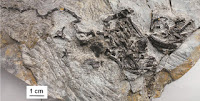The Mesozoic Era is noted for a wide range of Marine Reptiles, with diverse marine ecosystems coming to be dominated by animals derived from terrestrial descendents. This fauna first began to appear in the Middle Triassic, as ocean ecosystems were still recovering from the End Permian Extinction Event, making the early Marine Reptiles of the Middle Triassic of particular interest to palaeontologists. One remarkable animal from this period is Atopodentatus unicus, which was first described in a paper published in the journal Naturwissenschaften on 23 January 2014 as a highly aberant (unusual) Sauropterygian (the group which gave rise to later groups such as the Nothosaurs and Elasmosaurs) from the Middle Triassic of Yunnan Province, with highly specialized dentition, possibly adapted to filtering invertebrates from soft sediments through a highly developed tooth-comb. However the original specimen retained only fragmentary skull material, including part of the left jaw showing this tooth-comb, making a full assessment of the animal's feeding biology impossible.
In a paper published in the journal Science Advances on 6 May 2016, Li Chun of the Institute of Vertebrate Paleontology and Paleoanthropology in Beijing, Olivier Rieppel of the Field Museum of Natural History in Chicago, Cheng Long of the Wuhan Centre of the China Geological Survey, and Nicholas Fraser of National Museums Scotland describe two further specimens of Atopodentatus unicus from the Middle Triassic Guanling Formation of Luoping County in Yunnan Province.
Prepared skull referred to the Middle Triassic Marine Reptile Atopodentatus unicus, exposed in dorsal view. Chun et al. (2016).
Both specimens show excellent preservation of the skull, revealing an unexpected 'hammerhead' shape to the front of the skull, made up of extensions of the pre-maxilary and maxilary in the upper jaw and dentary in the lower jaw. This creates an extended front surface to the snout, which has a single row of teeth on the upper jaw between two rows on the lower jaw. This is interpretted as having been used to scrape aquatic vegetation from the substrate, then squeeze water out through the tooth comb compacting the food mass.
Artist’s restoration of Atopodentatus unicus depicting it as a herbivore grazing on marine plants growing on a hard substrate in the eastern Tethyan Sea during Middle Triassic times. Using batteries of spatulate teeth lining the hammerhead expansions of both the upper and lower jaws, it would have been able to scrape off numerous pieces of plant matter into suspension in the water. This could then be sucked in and filtered by the long, thin, and closely packed needle-shaped teeth lining the main jaw rami. Y. Chen in Chun et al. (2016).
See also...
 Pappochelys rosinae: A Proto-Turtle from the Middle Triassic of Badem Württemberg, Germany. Turtles
have a fairly good fossil record, as would be expected...
Pappochelys rosinae: A Proto-Turtle from the Middle Triassic of Badem Württemberg, Germany. Turtles
have a fairly good fossil record, as would be expected... A large-bodied Crocodylomorph from the Middle Triassic of North Carolina. The Triassic Period was a time of
great evolutionary experimentation, with many new groups of...
A large-bodied Crocodylomorph from the Middle Triassic of North Carolina. The Triassic Period was a time of
great evolutionary experimentation, with many new groups of... A new Placodont specimen from the Late Triassic of Switzerland. Psephoderma alpinum is an armoured Placodont (a group of Marine Reptiles known only from
the Triassic and thought to be related to Plesiosaurs) known from a
number of locations
in the Alps. It has a long...
A new Placodont specimen from the Late Triassic of Switzerland. Psephoderma alpinum is an armoured Placodont (a group of Marine Reptiles known only from
the Triassic and thought to be related to Plesiosaurs) known from a
number of locations
in the Alps. It has a long...
Follow Sciency Thoughts on
Facebook.


